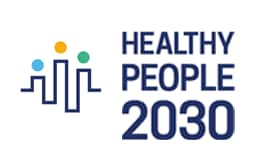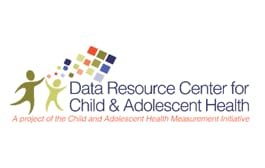Indicator Definitions – Sleep

Insufficient sleep duration (also called short sleep duration) refers to sleeping less than the recommended hours for a specific age group. About one-third of US adults, three-fourths of high school students, and one-third of children aged 4 months to 14 years have insufficient sleep duration.
Not getting enough sleep is associated with an increased risk of numerous chronic conditions—such as obesity, diabetes, hypertension, heart disease, stroke, anxiety, and depression. It can also cause motor vehicle crashes and workplace errors, as well as poor academic performance in children. The American Academy of Sleep Medicine recommends keeping a consistent sleep schedule, establishing a relaxing bedtime routine, and limiting bright light exposure in the evenings to establish healthy sleep habits and improve sleep duration.
Visit Sleep and Sleep Disorders | CDC for more information about short sleep duration.
Definition Details
| Population: | Children aged 4 months to 14 years old |
| Numerator: | Children aged 4 months to 14 years whose parents report they usually get insufficient sleep duration (<12 hours for children aged 4–12 months, <11 hours for children aged 1–2 years, <10 hours for children aged 3–5 years, <9 hours for children aged 6–12 years, and <8 hours for children aged 13–14 years), on average day (for children aged 0–5 years) or average weeknight (for children aged 6–14 years).1 |
| Denominator: | Children aged 4 months to 14 years whose parents reported child’s hours of sleep on average day (for children aged 0–5 years) or average weeknight (for children aged 6–14 years). |
| Measure: | Prevalence (crude) from a 2-year cycle |
| Time Period of Case Definition: | Average day (for children aged 0–5 years) or average weeknight (for children aged 6–14 years) |
| Summary: | During 2020–2021, insufficient sleep duration (<12 hours for children aged 4–12 months, <11 hours for children aged 1–2 years, <10 hours for children aged 3–5 years, <9 hours for children aged 6–12 years, and <8 hours for children aged 13–14 years, on average) was reported for 35.0% of children aged 4 months to 14 years.2 Insufficient sleep duration among children is associated with an increased risk of a number of conditions—such as obesity, diabetes, poor mental health, attention and behavior problems, and poor cognitive development.1,3 Parents can support the practice of good sleep habits to improve sleep duration in their children by setting appropriate regular bedtimes and limiting screentime use.4,5 |
| Notes: | Indicator does not convey variation in sleep duration (for instance, weekday vs. weekend sleep) or quality of sleep. Both might affect the risk for chronic disease. Indicator does not identify specific sleep problems, such as sleep disordered breathing and insomnia, which are associated with different chronic conditions. |
| Data Source: | National Survey of Children’s Health (NSCH) |
| Related Objectives or Recommendations: | Healthy People 2030 objective: EMC-03. Increase the proportion of children who get sufficient sleep |
| Related CDI Topic Area: | School Health |
| Reference 1: | Paruthi S, Brooks LJ, D’Ambrosio C, et al. Recommended amount of sleep for pediatric populations: a consensus statement of the American Academy of Sleep Medicine. J Clin Sleep Med. 2016;12(6):785–786. doi: 10.5664/jcsm.5866. |
| Reference 2: | Increase the proportion of children who get sufficient sleep — EMC 03: data. U.S. Department of Health and Human Services. Healthy People 2030. Accessed October 26, 2022. https://health.gov/healthypeople/objectives-and-data/browse-objectives/children/increase-proportion-children-who-get-sufficient-sleep-emc-03 |
| Reference 3: | Wheaton AG, Claussen AH. Short sleep duration among infants, children, and adolescents aged 4 months–17 years — United States, 2016–2018. MMWR Morb Mortal Wkly Rep. 2021;70:1315–1321. doi: 10.15585/mmwr.mm7038a1 |
| Reference 4: | Pyper E, Harrington D, Manson H. Do parents’ support behaviours predict whether or not their children get sufficient sleep? A cross-sectional study. BMC Public Health. 2017;17:432. doi: 10.1186/s12889-017-4334-4. |
| Reference 5: | Hale L, Guan S. Screen time and sleep among school-aged children and adolescents: a systematic literature review. Sleep Med Rev. 2015;21:50-58. doi:10.1016/j.smrv.2014.07.007 |
| Population: | Students in grades 9–12 |
| Numerator: | Students in grades 9–12 who report usually getting insufficient sleep duration (<8 hours for those aged 13–18 years, on average school night).1 |
| Denominator: | Students in grades 9–12 who report hours of sleep on average school night. |
| Measure: | Prevalence (crude) |
| Time Period of Case Definition: | Average school night |
| Summary: | In 2019, 77.9% of United States high school students reported insufficient sleep duration (<8 hours for those aged 13–18 years on average school night).2 Insufficient sleep duration among high school students is associated with an increased risk of a number of conditions—such as obesity, diabetes, injuries, poor mental health, attention and behavior problems, and poor academic performance.1 Parents can support the practice of good sleep habits to improve sleep duration in their children by setting appropriate regular bedtimes and limiting evening light exposure and technology use.3,4 |
| Notes: | Indicator does not convey variation in sleep duration (for instance, weekday vs. weekend sleep) or quality of sleep. Both might affect the risk for chronic disease. Indicator does not identify specific sleep problems, such as sleep disordered breathing and insomnia, which are associated with different chronic conditions. |
| Data Source: | Youth Risk Behavior Surveillance System (YRBSS) |
| Related Objectives or Recommendations: | Healthy People 2030 objective: SH-04. Increase the proportion of high school students who get enough sleep |
| Related CDI Topic Area: | School Health |
| Reference 1: | Paruthi S, Brooks LJ, D’Ambrosio C, et al. Recommended amount of sleep for pediatric populations: a consensus statement of the American Academy of Sleep Medicine. J Clin Sleep Med. 2016;12(6):785–786. doi: 10.5664/jcsm.5866 |
| Reference 2: | U.S. Department of Health and Human Services. Healthy People 2030. Increase the proportion of high school students who get enough sleep — SH 04: data. Accessed October 26, 2022. https://health.gov/healthypeople/objectives-and-data/browse-objectives/sleep/increase-proportion-high-school-students-who-get-enough-sleep-sh-04/data |
| Reference 3: | Pyper E, Harrington D, Manson H. Do parents’ support behaviours predict whether or not their children get sufficient sleep? A cross-sectional study. BMC Public Health. 2017;17:432. doi: 10.1186/s12889-017-4334-4 |
| Reference 4: | Bartel KA, Gradisar M, Williamson P. Protective and risk factors for adolescent sleep: a meta-analytic review. Sleep Med Rev. 2015;21:72–85. doi: 10.1016/j.sleep.2016.07.007 |
| Population: | All adults |
| Numerator: | Adults who report usually getting insufficient sleep duration (<7 hours, on average, during a 24-hour period).1 |
| Denominator: | Adults who report 1–24 hours of sleep. |
| Measure: | Prevalence (crude and age-adjusted) |
| Time Period of Case Definition: | Average 24-hour period |
| Summary: | In 2020, 35% of United States adults reported insufficient sleep duration (<7 hours for those aged ≥18 years, on average, during a 24-hour period).2 Insufficient sleep duration is associated with an increased risk of a number of chronic conditions—such as obesity, diabetes, hypertension, heart disease, stroke, anxiety, and depression.1 Insufficient sleep duration can also cause motor vehicle crashes, industrial errors, and medical errors causing substantial injury and disability each year.1,3 Keeping a consistent sleep schedule, establishing a relaxing bedtime routine, and limiting bright light exposure in the evenings are some of the ways to improve sleep.4 |
| Notes: | Indicator does not convey variation in sleep duration (for instance, weekday vs. weekend sleep) or quality of sleep. Both might affect the risk for chronic disease. Indicator does not identify specific sleep problems, such as sleep disordered breathing, which are associated with different chronic conditions. Indicator is part of the rotating core and is administered in even years. |
| Data Source: | Behavioral Risk Factor Surveillance System (BRFSS) |
| Related Objectives or Recommendations: | Healthy People 2030 objective: SH-03. Increase the proportion of adults who get enough sleep duration |
| Related CDI Topic Area: | None |
| Reference 1: | Watson NF, Badr MS, Belenky G, et al. Recommended amount of sleep for a healthy adult: a joint consensus statement of the American Academy of Sleep Medicine and Sleep Research Society. Sleep. 2015;38(6):843–844. doi: 10.5665/sleep.4716 |
| Reference 2: | Centers for Disease Control and Prevention. Sleep and sleep disorders. Data and statistics: Adults. Accessed October 26, 2022. https://www.cdc.gov/sleep/data-and-statistics/Adults.html |
| Reference 3: | Institute of Medicine (US) Committee on Sleep Medicine and Research. Sleep Disorders and Sleep Deprivation: An Unmet Public Health Problem. Washington (DC): National Academies Press (US); 2006. PMID: 20669438 |
| Reference 4: | American Academy of Sleep Medicine. Sleep education. Healthy sleep habits. Accessed October 26, 2022. https://sleepeducation.org/healthy-sleep/healthy-sleep-habits/ |



